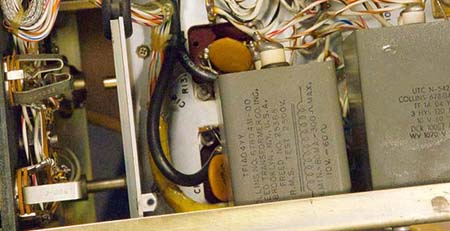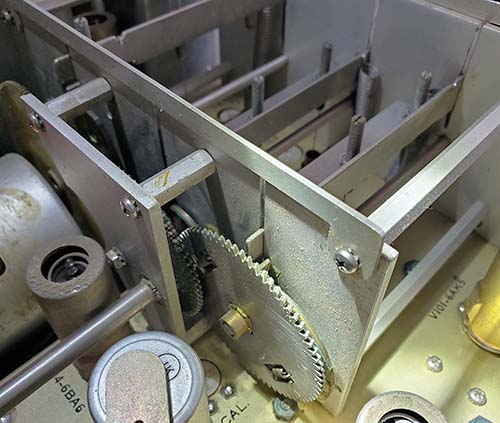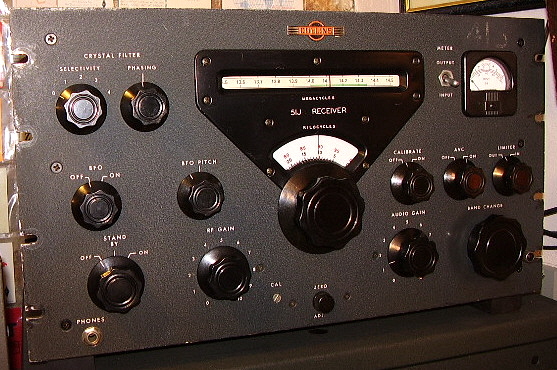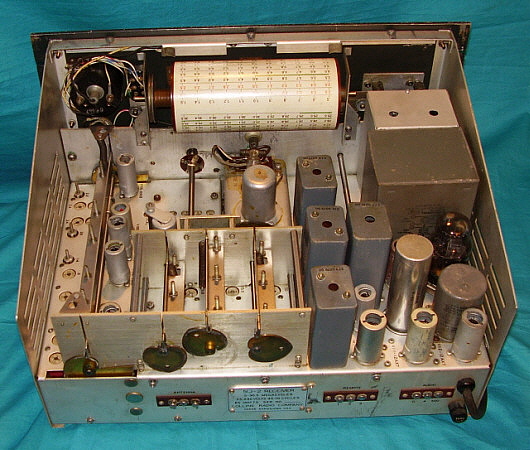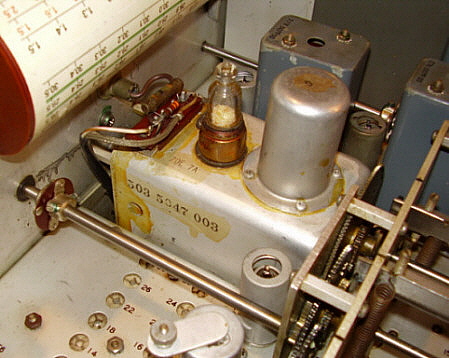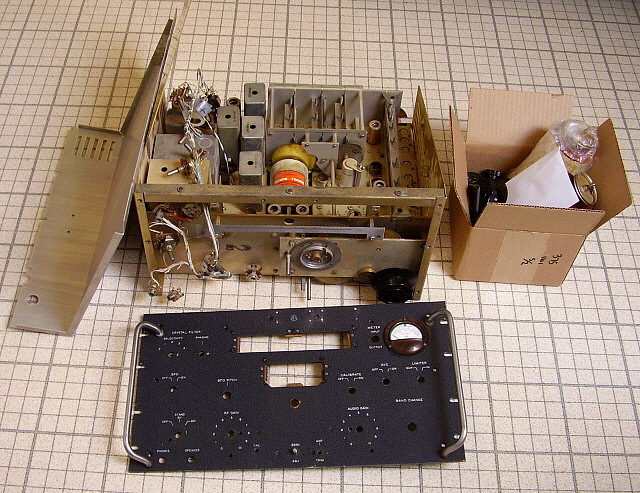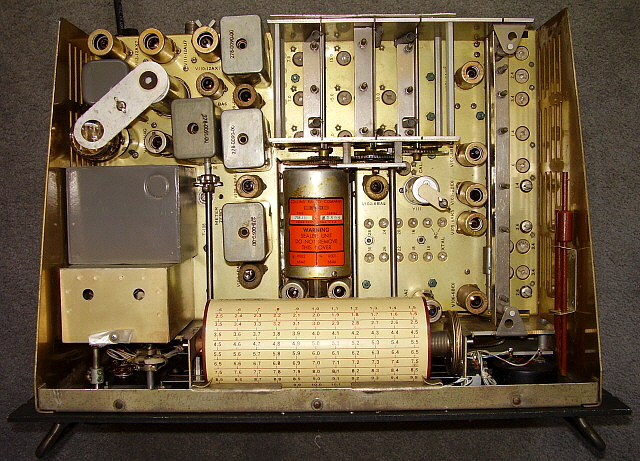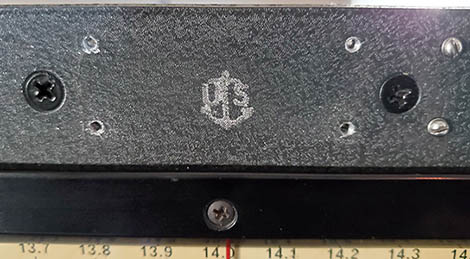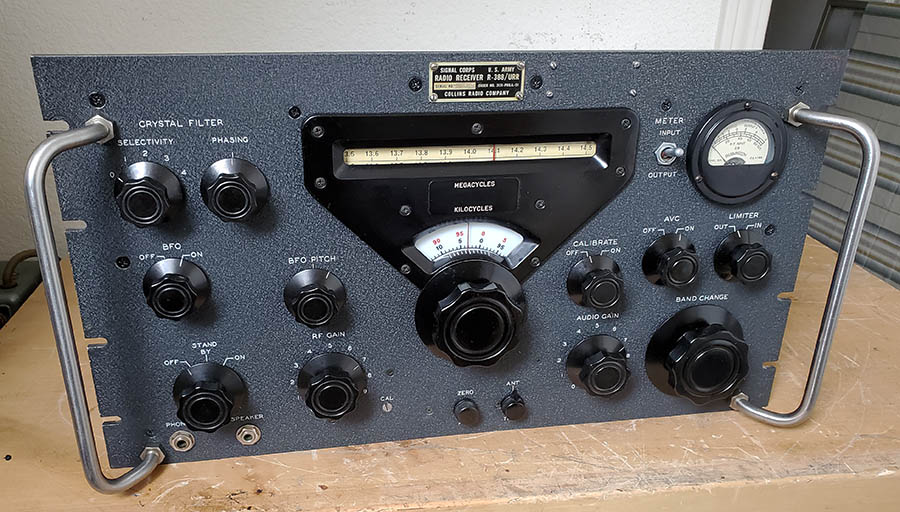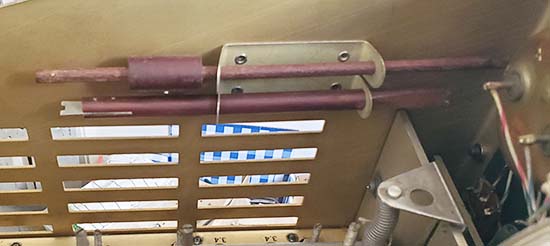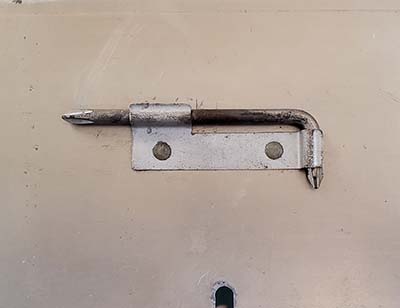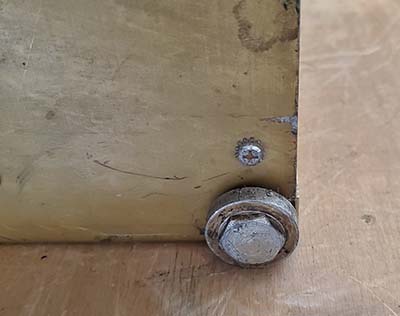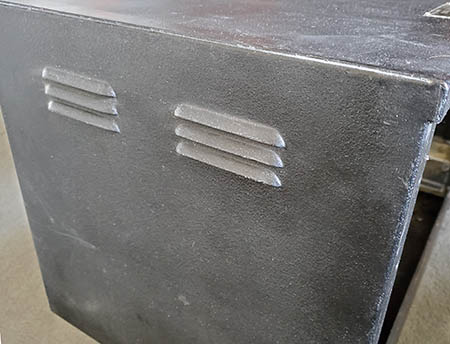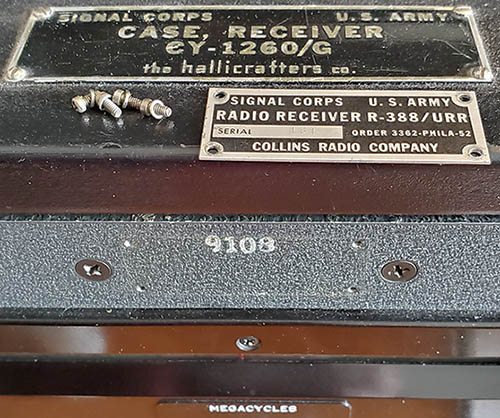|
The 70E-15
Uncorrectable End-Point Errors
The R-388 was the first receiver to use the new 70E-15 PTO.
Over the years, the 70E-15 has developed a deserved reputation
of being difficult to adjust and never being accurate. It has
long been thought that the type or mix of ferrite used for the
PTO core had aging problems that didn't show up immediately.
But, just how long did it take for the uncorrectable end-point errors to develop? One clue
would be Bill Orr's Ham Radio magazine article on the 70E-15 PTO and its EPE
errors and how to correct them. That write-up was from December
1969, long after the R-388 contracts had ended and long after the last of the
51J-4 receivers had been built. It's very likely that the
70E-15 EPE problems really developed into serious problems around the
late-1950s,
long after the major quantities of R-388 had been already built
(the last contract for R-388 receivers was a small one in 1962
but the majority of R-388 receivers were built from 1951 through
1953.)
As it became apparent that something in
the 70E-15 was causing an ever-increasing number of PTOs to
develop uncorrectable end-point errors, meaning that the normal
L trimmer adjustment had insufficient range to bring the PTO back
into specification, the first thought was that the aging ferrite
core was
causing the problem. It should be pointed out that all types of
Collins PTOs will change calibration over time and it was
expected. That's why the L-trimmer was provided. It's probably
also why the 70E-15 PTOs were "sealed in a vacuum" and
why Collins urged
that PTOs must be returned to Collins for calibration correction
where the vacuum seal was the last step in the process before
the corrected PTO was returned. However, the PTOs weren't
returned to Collins very often and therefore most PTOs had their
vacuum seal lost with the first adjustment correcting the EPE and
thereafter the components inside, including the ferrite, were
exposed to the air and moisture which could then "age" the PTO differently than Collins had anticipated. I don't think
that there ever were any changes made to the 70E-15 because by
the time the uncorrectable EPE problem became apparent all
major production of receivers that used that type of PTO had ceased. Collins
probably realized that the problem wasn't something that
developed quickly. It took about ten years for the ferrite
aging and the uncorrectable EPE errors to even become noticed. While
the ferrite core might develop the EPE problem just by aging, it
seems that the operational environment, where the
R-388 receivers were often turned on 24/7, could also have been an
important part of
the cause, perhaps accelerating the problem. Since the R-388
contracts were mostly completed and the 51J-4 production was
slowing down by the time the excessive EPE
problems became widely known, Collins certainly wouldn't have
put too much time into analyzing a problem that didn't affect
current production and really took about a decade to "show up" in out-of-production
receivers and then only in receivers operated 24/7. Collins did
produce a write-up specifically on the 70E-15 PTO around 1959 but exactly
what is covered in that document is currently unknown (I
can't find it on the Internet or from CCA. It's mentioned in a
Hollow State Newsletter but apparently Dallas Lankford couldn't
find a copy of it either.) About the only research on the 70E-15 problem has been by
collectors, starting with Bill Orr back in 1969. Orr's solution
of removing one turn on the L-trimmer has been the "fix"
necessary to return the 70E-15 to its normal accuracy. What I've
noticed, although my examples are certainly limited, is that
nearly all R-388 receivers (12 receivers examined) had
excessive EPE and out of three 51J-4 receivers examined, none
had uncorrectable EPE. With the 51J-4 being a
civilian receiver it was much less likely to be operated 24/7 and
therefore the heat-build up never happened with the result being
that the 70E-15 PTOs
in 51J-4s are seldom found with excessive EPE that can't be
corrected with just a standard adjustment of the L-trimmer. This means that nearly ALL
R-388 receivers will have a 70E-15 PTO with excessive EPE due to the
24/7 operation of the receiver. Of course, a point could be made
that the R-390 and R-390A PTOs, the 70H-12, were designed to operate inside
an oven and these PTOs are never found with excessive EPE that
can't be adjusted out. Collins could and did produce the 70H-12
for a heated environment so why would the 70E-15 be adversely
affected by 24/7 heat build-up? The 70H-12 was "pressurized"
with nitrogen, an almost inert gas, which might have had
something to do with the longevity of the PTO calibration but,
like the 70E-15, the first EPE adjustment releases the N2 and
air enters the PTO (I've only found one 70H-12 that still had
N2 pressure when I removed the plug to adjust the EPE - an
excellent seal that lasted for decades - but still, the EPE
needed a slight "touch-up" after those decades.) For the 70E-15, this again points to the
combination of the ferrite core mix along with 24/7
operation and perhaps loss of vacuum accelerating the aging and,
even then, a problem that really didn't develop for almost a
decade. The upshot is that ANY 70E-15 PTOs
might be found with uncorrectable EPE problems but almost all "problem"
PTOs will be found in R-388 receivers and rarely found in 51J-4
receivers. The good news is Bill Orr's solution is a relatively easy "fix" for the
excessive EPE problem found in R-388 receivers. The other good
news is that ALL 51J-4 receivers have their 70E-15 PTO
identified with a "CR" or "C.R." suffix added to the serial
number. ALL R-388 receivers have their 70E-15 PTOs
identified with a "M" prefix to the serial number.
There are 70E-15 PTOs that don't have a prefix or a suffix on
the serial number. These PTOs have been found in 51J-3 receivers
and also later as replacement spares. So,
even if the PTO has been removed from a receiver, it's still
possible to tell in which receiver the PTO was used. I don't
believe there was any difference in the specs or the performance
between the "M" and the "CR" PTOs or the
PTOs without prefixes or suffixes. The letter suffixes and
prefixes were only an identification that showed in which
receiver that particular 70E-15 was installed. >>> |
|

1951 R-388 PTO with "M" prefix serial
number |
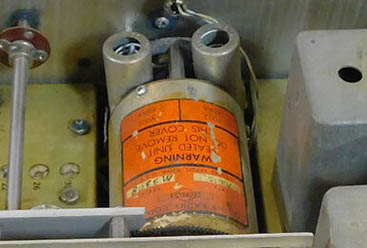
1953 R-388 SN:4991 PTO with "M"
prefix SN |
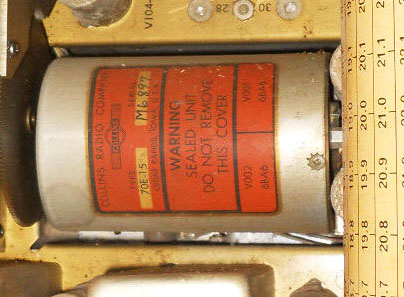
1953 contract R-388 (no data plate
- break in sw) Late SN PTO with "M" prefix |
| >>> Now, I've found R-388 receivers with the "M" PTO that
haven't been worked on and didn't have an
EPE that couldn't be adjusted to <1kc, but it's very rare
(1 out of 12 receivers examined.) Nearly all R-388
receivers (that haven't had the PTO worked on) will have an
end-point error greater than 6kc which is just beyond the
compensation adjustment. Nearly all "M" PTOs that I've tested have been
in the 8kc to 12kc area of EPE. The worst one I've ever tested was barely working and had an EPE
of 30kc! The best 70E-15 I ever tested was a NOS spare that was
found
still in the original box. This PTO had no EPE! The NOS
PTO does
seem to indicate that long-term heat from 24/7 operation is responsible for the
change in the ferrite core that causes the "M" PTO EPE problems,
not just aging. It's also possible that since the NOS PTO hadn't
ever been adjusted, it was still a "sealed vacuum" environment
and that slowed the aging of the ferrite. Another point, if your initial testing of the PTO shows, for
example 3kc EPE,...you don't really know if it's been adjusted before and that's
the best achievable EPE "as-is." So, testing and some L002 (EPE
compensation trimmer inductor)
adjusting will be required to determine the actual PTO
condition. |
|

PTO in 1960 51J-4 SN:4723 showing the "CR" suffix
|
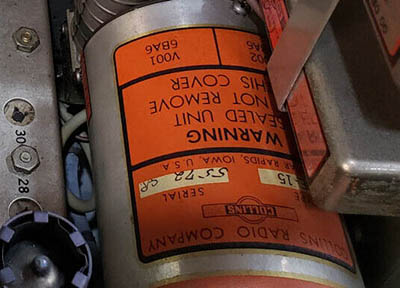
PTO in 1959 51J-4 SN:3805 |
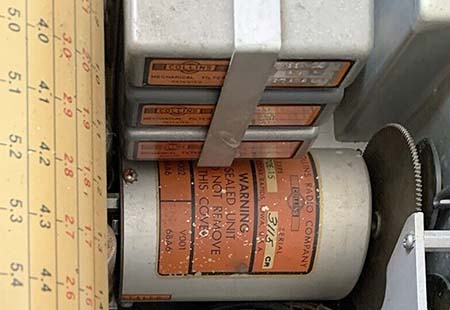
PTO in 1956 51J-4 SN:1616 |
|
70E-15 "M" and "CR"
Serial Numbers - More Info and Production Discrepancies |
|
70E-15 PTO Serial Numbers in General - First,
I don't believe there was any difference in
specifications or performance between the "M" or the
"CR" PTOs. 70E-15 PTOs are all the same. The letter
suffixes and prefixes were just an indication of which
receiver the PTO was installed in. It seems that the PTO
label was probably serialized and installed during the
calibration of the PTO. Since there appears to have been
at least two different serial number rosters, "M" and
"CR" must have been either stocked separately or the
PTOs were calibrated for the particular receiver during
assembly. There is evidence that many PTO serial numbers
didn't have either a prefix or suffix and just had
numbers. Although there aren't many examples of the "no
prefix/suffix" PTOs, it's possible they were serialized
using the same "M" roster numbers and just the "M"
prefix not used since the PTO wasn't installed in a
R-388 receiver. The early "no prefix/suffix" PTOs have
been found in 51J-3 receivers with PTO serial numbers of
945 and 5991. Exactly when the use of the "CR" started
isn't known at this time but it was probably near the
end of 51J-3 production or perhaps at the beginning of
the 51J-4 production. The 70E-15 PTO serial numbers
appear to be a sequential block of numbers within the
"M" prefix and another sequential block of numbers
within the "CR" suffix units. All 70E-15 PTO serial numbers examined, so far,
seem to show an ever-increasing progression of the
associated block numbers assigned as the receivers they are found in are
obviously of later and later manufacture. The highest PTO "number" I've seen so far has been
11802. It's usually estimated that about 12,000 R-388 receivers were
built and the quantity of "M" PTO serial numbers seem to agree with that
estimate. The 70E-15 PTO "M-11254-C8" is the highest
serial number actually marked with a "M" prefix, seen so far. All indications are that only the 70E-15 "M" PTOs
were installed in R-388 receivers and that would imply
that just over 11,000 R-388 receivers were produced.
The 51J-3 seems to have used the 70E-15 with "no
prefix/suffix" serial numbers, the 51J-4 always used the "CR" PTO and
all R-388 receivers have "M" PTOs installed. The 51J-4
PTO serial numbers start at 1500 "CR" PTOs but
that could just be when Collins started putting "CR" on
the "no prefix/suffix" PTOs. If the "no
prefix/suffix" PTOs were serialized from the "M" roster,
they would be part of the 11,000+ PTOs used in
R-388/51J-3 receivers. The "CR" PTOs should account for
about 7500 PTOs installed in the 51J-4 production (with
PTO SNs from 1500CR to 9000CR.) This
amount of PTOs is approximately equal to the estimated
R-388/51J-3 and 51J-4 production total, or about 20,000
receivers.
Very Late Serial Number 70E-15 PTO - Sometime
after the R-388 contracts ended and the last 51J-4
receiver was built, the "CR" suffix or the "M"
prefix were
dropped because any 70E-15 PTOs required or sold would
be considered
"spares," that is, replacement 70E-15 PTOs. One example of the "spares" 70E-15
PTO was found in a "R-388 to 51J-4" conversion
(installation of the 354A-1 Mechanical Filter Kit.) The
serial number on this PTO is 11277. It's possible that
the mechanical filter kit and the PTO were both
purchased from Collins specifically for this conversion
that probably was performed after the R-388 became an
affordable surplus receiver. Since the last R-388
contract was in 1962 and the last 51J-4 was in 1964, a
good guess for this PTO would probably be about 1965.
Since this PTO was a replacement and was "new" in 1965,
it's interesting that this later 70E-15 PTO has a tested EPE
of 7.5kc!
This was totally unexpected! But it does seem to confirm that no
changes were ever made to the type of ferrite used for the cores and
something else, like excessive heat from 24/7 operation, affects the majority of PTOs
used in R-388 receivers but doesn't seem to affect 51J-4
receivers. The "conversion receiver" did have many indications of
hours and hours of use meaning that the receiver
was used as a commercial monitor (post-conversion) where
it was probably operated continuously (although I
knew a ham once that left his equipment powered up
24/7,...he didn't use it all the time,...but the
equipment was always "on" and ready to be used.
Of course, his vacuum tube equipment failures required
constant maintenance.) |
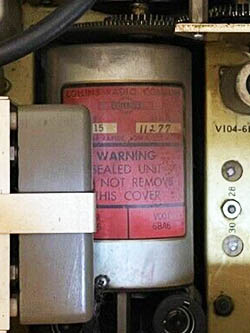
70E-15 SN: 11277
This PTO was installed in a 1951 R-388 that was
converted into a 51J-4 with a 354A-1 kit |
|
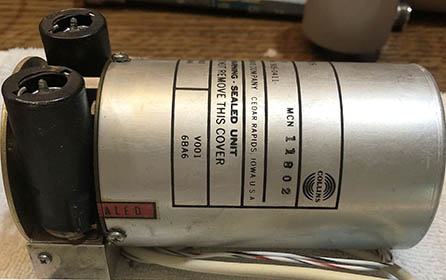
1968 70E-15 PTO
SN:11802 |
An Even Later 70E-15
PTO - This NOS 70E-15 PTO turned up on
eBay on June 14, 2023. What is important about this PTO
is that the Tested card and QC record card were included
(and photographed.) The PTO serial number is shown on
the PTO as 11802. It's also shown on the cards as Mfg.
No. 11802.
What's very interesting is the date,...1068. This is a
date code that indicates the 10th week of 1968, or from
about the first week in March, 1968. The serial number
11802 is 525 units higher than 11277 shown above. This
seems to confirm that 11277 is from the "mid-1960s."
It's also interesting that 525 units earlier and the
70E-15 PTO was still using the old original style orange
label but by 11802 a new style transparent label (or
silk screening) was being used. Note the serial number
is an ink-stamped number. Also note the Collins
"Meatball" logo. Also note the prefix "MCN"
that's part of the silk-screen label. The TESTED O.K.
card has 11802 shown as the Mfg No. and the acceptance
stamps have "CR TEST" (one would assume "Collins Radio
Test.") NOTE:
One of these types of PTO (labels) is installed in 51J-4
SN:6977 but unfortunately the SN of the PTO isn't
visible in the photograph. This 51J-4 also has S-line
knobs installed. |

11802 Inspection Cards |

70E-15 PTO SN: M 11254 C.R. |
Another 70E-15 "M"
PTO with 11,000+ Serial Number,...or is it a "CR"
suffix? -
This PTO showed up on eBay on July 7, 2023. The serial
number has the "M" prefix indicating it was installed in
a R-388. However, there's also a suffix of "C.R." that indicates
it was for a 51J-4. There appears to be no MFP on the
unit. The
11254 number is the highest "M" serial number seen
that actually has the "M" prefix, so
far. It's also a very high number for a J-4 "CR" PTO. Unfortunately, only the PTO exists so the receiver
it was removed from is unknown. This PTO should date from
the early-1960s. Note that this SN is just 23 units
higher than the replacement PTO installed in the R-388
with the 354A-1 MF kit installation. As to why it has both the "M" prefix
AND the "CR" suffix are on this PTO? Confusion at Collins?
UPDATE: Sept 29, 2023 - I ended up
purchasing this very PTO off of eBay when the seller
lowered the price to $30. I'll be adding some test
information on this "M" or "CR" PTO. It will be especially
interesting to see what the end-point error is.
EPE Test Results:
- Not so good,...15kc EPE. Second highest I've seen that
still works. |
 |
| The Argument for "M" and "CR"
Having Specific Serial Number Blocks
- An interesting anomaly can be seen in the 1953 R-388 PTO sn: M3308 (shown above
upper right) compared to the 1956 51J-4 PTO with sn: 3115CR
(shown above lower right.) It appears the earlier receiver has a
later PTO if just the "numbers" are used. It's interesting that the actual serial numbers of these two PTOs are separated by only 192 units and yet 3308 has the "M"
prefix indicating it was for a R-388 and 3115 has the "CR"
suffix indicating it was for a 51J-4. It seems probable that "M"
and "CR" PTOs each had their own blocks of numbers. Another
interesting comparison is between the 1953 R-388 with PTO sn
M6897 and the 1960 51J-4 with PTO sn 6667CR. Again, this comparison
seems to further indicate that "M" PTOs used their own block of
numbers and "CR" PTOs used their own block of numbers.
Although a third block of serial numbers for "no
prefix/suffix" PTOs would seem unlikely, anything is possible
with Collins and their methods of serializing.
51J-3 - At the
moment, I'm not sure about genuine 51J-3 receivers since I've
never inspected an authentic one in person. The two confirmed
51J-3 serial numbers with PTO serial number information seem to
indicate that the 51J-3 used a PTO that was serialized with just
a number, no letter prefix or suffix. The two PTOs are serial
numbers 945 and 5991. These numbers seem to imply that the 51J-3
used the same PTO serial number roster as the "M" PTOs but
didn't use the "M" prefix since that was exclusively for R-388
receivers. If
the 24/7 long-term heat
is partly responsible for the excessive EPE problem in 70E-15
PTOs, then the
51J-3 PTO should behave like those found in the 51J-4. The
70E-15 SN: 945 from the 51J-3 with Collins production
number 6636 is shown to the right. IF the Collins
Mfg SN on all R-388/51J-3 receivers had a relationship
to Order Numbers on the R-388 series contracts then
Collins SN:6636 would seem to be from early 1952,...but,
that's a lot of assumptions.
More
details on how to correct excessive EPE in the PTOs is in the section "Reworking the 70E-15 'M' PTOs"
further down this page. |

70E-15 PTO SN:945 from
51J-3 Collins Mfg SN: 6636 |
| More 70E-15 Info - Here's a photo of a 51J-2
receiver with a 70E-15 PTO installed in place of the
original 70E-7A PTO. Note a couple of interesting things
about this 70E-15,...first, the serial number is 72. It
must have been among the first ones made. Next, note
that there isn't a "M" prefix or a "CR" prefix. The
final interesting point is this particular 51J-2
receiver was a Collins Laboratory receiver. It has the
light gray front panel. It also has the Collins asset
number engraved on the upper right corner of the front
panel. There's no question that Collins performed this
upgrade of installing the 70E-15 PTO into this 51J-2
receiver. The serial number of the 51J-2 receiver is
650. |
 |
|
Break-in Operation for the
R-388, 51J-3 and 51J-4 - What a Headache! - Perhaps the most inconvenient
requirement for the R-388,
51J-3 or the 51J-4 is how to provide the Break-in
function. Break-in requires an external +12vdc 200mA source that is switched
"on" when in the
"transmit" mode to isolate the receiver input and to mute the
audio output. Inside the receiver, relay K101 is operated by the
Break-in voltage and the
relay contacts disconnect the antenna input line, ground the receiver input
circuitry and also remove the voltage
from the IF amplifier plates to mute the receiver. There is also a neon
bulb as a protection device on the antenna line but this is mainly a
static voltage drain and not intended to handle large amounts of RF
energy. Break-in should be used when the receiver is paired with a
transmitter and both are using the same antenna switched by an external
T-R relay. Usually, the T-R relay does provide positive
isolation and many Dow-Key T-R relays had an additional spring-loaded
contact switch inside the
receiver-side coaxial fitting barrel that further increased receiver
isolation. These types of T-R relays afford protection when used with
the Standby position for muting in the short term and it's fine
for testing and preliminary set-ups but, ultimately, the permanent
set-up should be using the Break-in with the T-R relay to provide a positive
"double" disconnect of the antenna
line and providing the grounding that protects the receiver input,...just in case there's
a T-R relay failure and arcing happens inside the relay.
IMPORTANT NOTE: The front panel
STAND BY position does not actuate the Break-in relay.
The Break-in relay can ONLY be operated by applying +12vdc
Break-in voltage to pins 2 and 3 of the
REMOTE terminal strip (pin 1 provides a ground for
a cable shield.)
NOTE 1 - If you can't use an external +12vdc for Break-in: There are a couple of methods that provide
the +12vdc "Break-in" within the receiver. Either a small power supply
mounted under the chassis of the receiver or a voltage doubler circuit
that runs off of the 6vac tube heater supply. Since < 200mA is required
to operate the relay K101, very small components can be used for either
power supply circuit. See "R-388 Expected
Performance and Operation" further down in the "Rebuilding the R-388/URR
Receiver" section. NOTE 2 -
Sensitvity down on 80M and 40M?: If your R-388 or 51J-4
receiver seems to have somewhat less sensitivity on Bands 4 through 7,
which happens to be the bands that include the 80M and 40M ham bands,
check L-104 for burn marks and for its DC resistance. Refusal by some
hams to use the "Break-in" function and instead relying on a T-R relay
for isolation (along with using the STAND BY for muting) can lead to accidental high levels of RF
making it to L-104, the Antenna coil for Bands 4-7, causing damage.
Typically, the receiver still works but sensitivity will be down on Bands 4-7. A check will
involve testing reception levels on Bands 8 and higher and noticing an
increase in sensitivity on those bands. Also, check the response using
the Calibration function. If received signals seem down on 4mc but switching in the
Calibration oscillator shows a good response on the CL meter, then
suspect damage to L-104 from excessive RF levels (and not using Break-in.)
The Calibration oscillator is injected at the grid of the RF amplifier
tube which is after L-104 in the signal flow, so, the poor
sensitivity on an antenna but a good CAL response might indicate L-104
damage. Be sure in your
testing that the lack of sensitivity isn't due to an antenna mismatch. The final test and
confirmation requires using a RF signal generator to input known signal
levels and to actually confirm that the sensitivity is down on Bands
4-7. When inspecting L-104, often excessive RF damage can be seen as
melting, discoloration or burn marks on the coil. Sometimes the
excessive heat will only change the DC resistance of the wire of the
coil and the damage shows up as an increase in the DCR of the coil.
Another observation is that even though the damage may have happened
during 80M operation, the damage also affects 40M sensitivity and
vice-versa. NOTE 3 -
The 51J-1 and 51J-2 have conventional stand-by
provisions providing external relay connections that parallel the front
panel STAND BY
switch. The auxiliary contracts on the T-R relay can provide the remote
Stand By function. There isn't any antenna input protection circuitry
provided in these early version receivers.
BFO/IF "Inversion" - Selecting Upper or Lower Sideband
with the 51J -
The double conversion process in the
51J circuit involves mixing the incoming RF with a Crystal Oscillator
(using fundamental and harmonic frequencies) to create Odd and Even Bands
for the dual Variable IF that are in turn mixed with the PTO output. The PTO tunes from 3.0mc to 2.0mc
but the Even Bands use the Variable IF that tunes from 1.5mc to 2.5mc.
This requires using the formula PTO f - Vari IF = +500kc fixed IF
(mid-range example 2500kc-2000kc=+500kc.)
However, an Odd Band uses the Variable IF tuning 2.5mc to 3.5mc and this
requires using the formula PTO f - Vari IF = -500kc fixed IF (mid-range
example 2500kc-3000kc= -500kc.) The 500kc fixed IF signal is actually
changing phase (180º) between Odd
Bands and Even Bands. Since the BFO is a 500kc oscillator
heterodyning with that 500kc IF, when the 500kc fixed IF phase changes,
the BFO phase relationship inverts. This shows up, for example, as tuning in
an USB 14.200mc SSB signal will require the BFO to be to the right of
the center index line for proper demodulation. But, if an USB 15.035mc SSB signal is tuned in then the BFO
must be to the left of the center index line for proper demodulation.
Since there aren't any calibration index lines to comprise a scale for the BFO position, the 51J design
never intended using the BFO for selecting a specific sideband nor
in providing a "calibrated position" for the BFO (as with the
later R-390 and R-390A.) It's really not that much of a problem but it's
something that's noticed quickly when first operating a 51J receiver
nowadays and tuning in SSB signals.
| It's
easy (if you use the receiver a lot) to remember that on Odd Bands USB
reception will require the BFO index to be to the left of the center
mark. If you're on an Even Band, USB will require the BFO index to be to
the right of the center mark. Or,...since 80M and 40M are both Odd Bands
and LSB is normally used there, have the BFO index to the right of the
center mark for those two ham bands. But, 15M is also an Odd Band but
USB is normally used there so the BFO index is set to the left of the
center mark for 15M. Even Bands are 20M, 17M and 10M and all typically
are USB so the BFO index is set to the right of the center mark for
those ham bands. The upper portion of 10M is an Odd Band so BFO to the
left for USB. It sounds confusing but once you've operated the
receiver a few times on SSB with taking into account the BFO inversion between Odd
and Even Bands, selecting the proper sideband is easy (see drawing to
the right.)
IMPORTANT NOTE: You have to be
sure that the BFO knob index is mounted correctly on the BFO shaft.
Setting up the
correct BFO knob position is covered in detail in any of the 51J
receiver's alignment procedure. The basic set up is to first rotate the BFO knob one full turn
clock-wise, then continuing C-W, set the BFO to the highest
frequency (fully unmeshed C) then, without moving the BFO shaft, mount the BFO
knob so its index is
at 90º
C-W from vertical. Then set the BFO index to vertical and align the BFO
coil assembly adjustment to 500kc. With this setting, if the BFO is rotated from
index-vertical to the right (or C-W) the BFO frequency will
increase from 500kc. If the BFO is rotated from index-vertical
to the left (or C-C-W) then the BFO frequency will decrease from
500kc. |

BFO Position for Sideband Selection |
Even Collins had a hard time with the Odd-Even Band changes and the
relationship with the BFO operation. When the 51J was designed at the
end of WWII, a BFO was only used for CW reception and, since a CW signal
has no sidebands, the position of the BFO didn't matter as long as it
provided a heterodyne. By the time the 51J-4 was introduced, SSB had
been developed and was being promoted by Collins. The 51J-4 manual has a specific set of instructions for determining
what Collins thought was the
proper setting of the BFO for SSB signals when using the J-4. The procedure requires
determining center frequency of a marker signal and then tuning below
the f center for a carrier level drop of 18db and then adjusting the BFO CCW for zero
beat and noting the knob's index position. The same procedure is again performed with
by tuning above f center for an 18db drop and tuning the BFO CW for zero
beat and noting the knob's index position. NOTE: It's strange that
the Collins instructions actually states the signal levels and the
signal drop as "3 S-units" and, of
course, all of the 51J-4 receivers had Carrier Level meters that read in
"db over" but Collins did provide the 18db level in parentheses. The instructions finish up by stating that
if the SSB signal can't be demodulated with the BFO in the proper CCW
position then rotate the BFO control to the proper CW position. In other
words, there's no specification of either "upper" or "lower" sideband
mentioned since obviously that changes depending on whether the band
being used is Odd or Even, which isn't mentioned either. It must have become too convoluted to explain
at a time when SSB transmissions were just becoming popular and just
beginning to be heard on the
air, so Collins avoided
it altogether. It also seems strange that Collins (at the time)
didn't mention the BFO inversions since this changing BFO relationship would
have affected reception of RTTY FSK signals. The BFO position determines whether the RTTY
FSK signal is
going to be received "Mark high f" or "Mark low f."
Of course, it depended on the type of RTTY TU. Those TUs that ran off of
the IF and supplied their own BFO might not have been affected.
However, some of the TUs were audio input types and relied on the
receiver BFO. These would have definitely been affected by the Odd-Even BFO
inversion but most RTTY audio TUs
had the ability to invert the relationship, if necessary, for this very
reason. Since the BFO
inversions are a product of the Vari-IF and PTO relationship, they will be experienced with all versions of the
51J series. I guess it's just one of
the 51J "oddities."
Communications-grade Audio, Loudspeakers and External Audio
Amplifiers for the 51J Series - If you're expecting high
fidelity audio from any of the 51J receivers, you're in for a
disappointment. The initial intent of the receiver was communications
and especially for receiving data-type transmissions. Communications-grade audio
response was generally considered 300hz to 3000hz for voice
transmissions. For CW or data, the audio bandwidth could be much
narrower. Most military transmitters (and most amateur transmitters at
the time) that were used for voice
communications kept the audio response approximately from 300hz to
3000hz. This was to assure that the best intelligibility was available
at the receiving-end. Voice transmitters, if their audio response was
set up to favor the lower voice frequencies, would have to lower the
audio gain level in the speech amp which in turn lowered level of
modulation. The voice's low frequencies have a lot of "speech power"
that would easily cause over-modulation. Most amateur and military voice
transmitters were fairly low power and
if they were set up with "bassy, low-modulation level" audio, the signal intelligibility
would be lost and copy would be difficult, if not impossible. All 51J-1
and 51J-2 receivers
have audio specification of 200hz to 2500hz at -6db down. Additionally,
the 51J-1 and 51J-2 have a very narrow IF bandwidth of about 4kc at
-6db. The R-388,
51J-3 and 51J-4 have audio specifications of 200hz at -3db down on the low end and 2500hz
at -7db down on
the high end with an IF bandwidth of about 6kc at -6db and 1.5 watts available audio power at less
than 15%
distortion. The 51J-4 widened the IF band width a bit more than that,
using a 3pf IF coupling C where the R-388 used a 2pf IF coupling C,
and added mechanical filters to the 500kc fixed-IF
that actually determined the band width and created a steep-sided, flat topped bandwidth that, while great for
selectivity, created serious audio issues in the AM mode using the 6kc
mechanical filter. Certainly not impressive
audio specs from any of the 51J Series,...especially if you're an
audiophile. But, the 51J receivers are "communications receivers" and
their audio specifications are appropriate for that type of end-use.
All of the advertising or
the manuals never specified a particular matching speaker for any of the
early 51J series of receivers. The 51J-1 and J-2 manuals provide
dimensions of the intended loudspeaker and these dimensions describe the
Collins 270G-1 (used an 8" loudspeaker.) The 51J-4 manual actually specifies the 270G-3 loudspeaker.
The 270G-3 used a 10" loudspeaker. During early production there was a
270G-2 10" loudspeaker available. There is conflicting information out
there (even from Collins) but it seems that the 270G-2 was identical to
the 270G-3 with the exception of the three small vertically-spaced holes
towards the front on each side of the cabinet for installing rack-mount brackets. Some
sources say it's the other way around, that is, the 270G-3 had the rack
bracket holes but the 1959 Collins production catalog shows the 270G-3
loudspeaker without the mounting holes for the rack brackets. Also, in
the 1959 Collins catalog the 270G-3 is listed as 6-8Z ohms however
actual impedance measurements of original
loudspeakers will normally show they are 4Z voice coils. Note that this
is a nominal impedance shown and that would vary depending upon
how the measurement is made, specifically the frequency employed. Figure
that the impedance specified is "NOMINAL" and whether the testing shows
4Z, 6Z or 8Z, all 270G-3 loudspeakers sound great when connected to the
4Z output terminals of any 51J receiver.
R-388 receivers were generally used for specific military set-ups such
as RTTY or other data transmissions where a loudspeaker would be part of
a larger, rack-mounted collection of equipment. In addition to the
rack-mounting option of the 270G-2, there also was a
rack mounted dual speaker system available for diversity RTTY set-ups. There was a USN version of the R-388 referred to
as the AN/URR-23-A that came in a standard Collins cabinet, CY-1235/U and included
the 270G-3 speaker (mil ID: LS-199/U.) The 51J-2 was also supplied in a similar fashion and
designated as the AN/URR-23 (no -A.)
For a vintage mil-rad station, perhaps
the easiest speakers to find (that are period and manufacturer correct)
would be either the Collins 270G-1, an 8" speaker, or the Collins 270G-3, a 10" speaker. The 270G-1 was typically supplied with the 75A-1
receivers and the speaker cabinet had the Collins "winged" emblem on the front with chrome
trim strips with a felt-flocked perf-metal grille (usually a sort of
brownish-maroon color.) The 270G-1 also has a serial number tag mounted
inside the cabinet showing the model designation and the serial number.
The 270G-3 was typically supplied with the 75A-2, 75A-3 and 75A-4
receivers and these cabinets don't have the Collins WE and have black
trim strips with an white-cream color felt-flocked grille. The 270G-3
doesn't have a serial number tag and wasn't assigned a serial number.
Either of these Collins speakers are fine sounding, communications-grade
reproducers and, though usually outrageously expensive, they are easy to find. However,
any 4.0Z speaker will function fine with the 51J receivers. There's not
too much of an advantage in using a high-quality, large diameter speaker
installed in a bass reflex cabinet because the audio output circuitry of
any of the 51J Series receivers was always "communications grade" in
quality. The audio range available with all 51J receivers lacks any
significant bass since
the audio output frequency response was rolled-off starting at 200hz on
the low end and the upper limit roll-off was at 2500hz while the audio power can only produce about 1.5
watts maximum. Even the latest version, the 51J-4, still has audio that was specified as 200hz
at -3db down to 2500hz at -7 db down in
the manuals with the 1.5 watts output power maximum (at <15%
distortion.) These less-than-impressive specifications will become more
and more apparent with better quality, high fidelity speaker systems.
Using the 600Z output to drive a loudspeaker through an appropriate
matching transformer is also an option. Using a good quality transformer
and a typical 8Z or 4Z loudspeaker will result in typical communications
audio reproduction. I do use the 600Z output from the front panel
SPEAKER jack to operate a rack mounted loudspeaker with dual R-388
rack-mounted receivers. The resulting audio is a little thin due to the
open rack nature of the loudspeaker but the communications quality is
excellent. With the very late R-388 receivers and all but the earliest of the 51J-4 receivers, the Diode Load was brought out to the rear chassis apron
as a test point jack. It would be possible to use a shielded cable
connected to the Diode Load and run that to the input of a High Fidelity
audio amplifier (using the aux. input or some other fairly Hi-Z input) to
drive a quality loudspeaker. You would lose the Noise
Limiter function but it was designed for repetitive pulse noise that
isn't heard very much nowadays. Also, the 51J-4's 6kc mechanical filter will
still be limiting any high quality AM reproduction so very few enthusiasts have
bothered with the external Hi-Fi amp set-up. However, it does depend
upon what type of stations are listened to. AM Broadcast from local
stations will sound pretty good on a J-4 if the receiver is tuned to the
carrier plus one
sideband allowing the audio to go up to about 6000hz (theoretically,...and
since AM-BC stations are limited to a 10kc bandwidth their transmitted
audio should only be up to about 5000hz,...theoretically.) Since there's no fading
or phase distortion with ground wave signals, this type of
reception might benefit from an external audio amplifier with bass and
treble controls to enhance the audio frequency response. Any SW-BC or AM
ham transmissions will be subject to skywave propagation conditions and
lack-luster signal strength that usually seriously affects audio
quality. Limitations on any local AM-BC would be in the program material
and that's pretty much the same for any AM-BC or SW-BC.
Since the 51J receivers have always been considered "communications
receivers," it's not unexpected that the standard
Collins communications-grade loudspeakers, the 270G-1 or the 270G-3, will give the best
results when used with any of the 51J receivers.
Cross-Modulation with R-388, 51J-3 and 51J-4 - The
first receivers, the 51J-1 and 51J-2, used RF transformers in the Ant/RF
input section of the receiver but this resulted in a fixed antenna input
impedance of 300 ohms. The Army found this terribly inconvenient since
most of their antennae were whip verticals or dipoles with impedances a
lot less than 100 ohms, let alone
300 ohms! Collins
modified the RF/Ant input section when implementing the changes needed
for the R-388 receiver. The change removed the primary winding on the
coils and just used a parallel LC for tuning the Ant/RF along with
adding an Antenna Trim to allow matching the antenna low impedances
better. It all works fine except if there's a really strong RF field
present. This could be a nearby AM-BC station or a neighboring ham
running a high power transmitter. To have a strong enough RF level that
could cause cross-modulation generally requires using a very large
random length wire antenna that's
directly connected to the receiver antenna input. The receiver's parallel LC Ant/RF
input section doesn't have much selectivity and that's why it's possible
for cross-modulation to happen if the RF field is sufficiently strong. The Army used mostly whip antennae and
so it wasn't much of a problem for them. I've heard about this
cross-modulation problem with the R-388 but I've never experienced it.
Certainly, in large urban areas where powerful AM-BC stations might be
nearby and numerous, along with the possibility of neighboring hams operating
powerful transmitters, the cross-modulation issue might be more likely
to occur. Using an end-fed wire antenna without any type of matching
network (tuner) will contribute to the susceptibility to cross-modulation. Here in Western Nevada,
I've always used large wire antennae but I've always used dipoles fed
with open wire feedline in combination with a selective type of antenna tuner. I
believe that the "tuned" antenna, which is essentially a selective LC
combination,
adds another "tuned stage" ahead of the receiver to compensate for the
reduced selectivity in the Ant/RF input section. Using large broad-band
or untuned (non-resonant) antennae might tend to
result in the R-388 being more susceptible to cross-modulation. A
selective "tuned" large wire antenna seems to work for me. Also, even if
I'm just listening to station outside of the ham bands, I'll always
"tune" the antenna for that frequency of reception. Again, the
tuning and resulting high-Q of the antenna might be
why I haven't experienced any cross-modulation issues. |



















